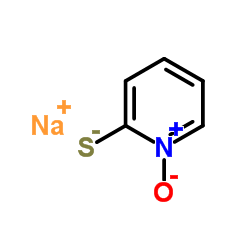Potent in vitro anti-Trypanosoma cruzi activity of pyridine-2-thiol N-oxide metal complexes having an inhibitory effect on parasite-specific fumarate reductase.
Marisol Vieites, Pablo Smircich, Beatriz Parajón-Costa, Jorge Rodríguez, Verónica Galaz, Claudio Olea-Azar, Lucía Otero, Gabriela Aguirre, Hugo Cerecetto, Mercedes González, Alicia Gómez-Barrio, Beatriz Garat, Dinorah Gambino
Index: J. Biol. Inorg. Chem. 13(5) , 723-35, (2008)
Full Text: HTML
Abstract
In the search for new therapeutic tools against Chagas disease (American trypanosomiasis) palladium and platinum complexes of the bioactive ligand pyridine-2-thiol N-oxide were exhaustively characterized and evaluated in vitro. Both complexes showed high in vitro growth inhibition activity (IC(50) values in the nanomolar range) against Trypanosoma cruzi, the causative agent of the disease. They were 39-115 times more active than the antitrypanosomal drug Nifurtimox. The palladium complex showed an approximately threefold enhancement of the activity compared with the parent compound. In addition, owing to their low unspecific cytotoxicity on mammalian cells, the complexes showed a highly selective antiparasite activity. To get an insight into the mechanism of action of these compounds, DNA, redox metabolism (intraparasite free-radical production) and two parasite-specific enzymes absent in the host, namely, trypanothione reductase and NADH-fumarate reductase, were evaluated as potential parasite targets. Additionally, the effect of metal coordination on the free radical scavenger capacity previously reported for the free ligand was studied. All the data strongly suggest that trypanocidal action of the complexes could mainly rely on the inhibition of the parasite-specific enzyme NADH-fumarate reductase.
Related Compounds
| Structure | Name/CAS No. | Molecular Formula | Articles |
|---|---|---|---|
 |
2-Mercaptopyridine N-oxide sodium
CAS:3811-73-2 |
C5H4NNaOS |
|
Antiviral activity of the zinc ionophores pyrithione and hin...
2009-01-01 [J. Virol. 83 , 58-64, (2009)] |
|
Nickel mobilizes intracellular zinc to induce metallothionei...
2009-07-01 [Am. J. Respir. Cell. Mol. Biol. 41 , 69-75, (2009)] |
|
Functional alterations of human platelets following indium-1...
1991-01-01 [Eur. J. Nucl. Med. 18(5) , 326-31, (1991)] |
|
D.H. Barton et al.
[Tetrahedron Lett. 24 , 4979, (1983)] |
|
D.H. Barton et al.
[Tetrahedron 41 , 3901, (1985)] |